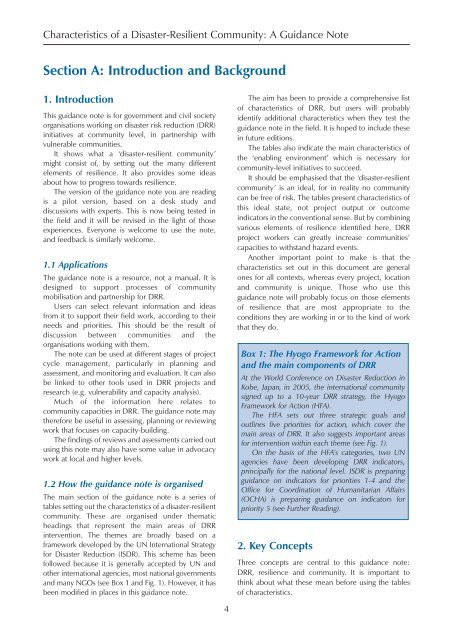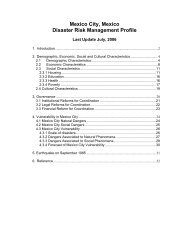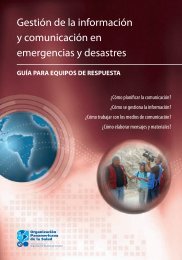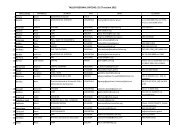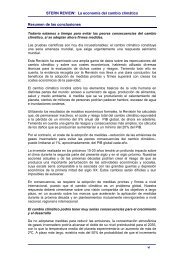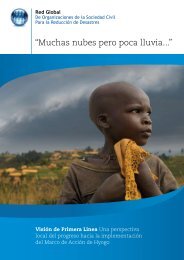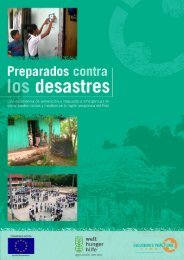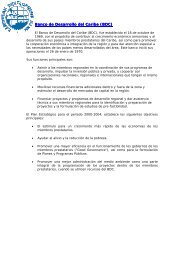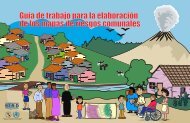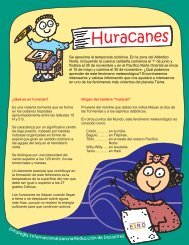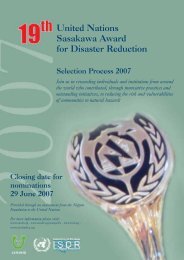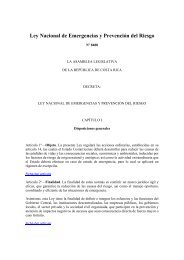Characteristics of a Disaster-resilient Community A ... - PreventionWeb
Characteristics of a Disaster-resilient Community A ... - PreventionWeb
Characteristics of a Disaster-resilient Community A ... - PreventionWeb
You also want an ePaper? Increase the reach of your titles
YUMPU automatically turns print PDFs into web optimized ePapers that Google loves.
<strong>Characteristics</strong> <strong>of</strong> a <strong>Disaster</strong>-Resilient <strong>Community</strong>: A Guidance NoteSection A: Introduction and Background1. IntroductionThis guidance note is for government and civil societyorganisations working on disaster risk reduction (DRR)initiatives at community level, in partnership withvulnerable communities.It shows what a ‘disaster-<strong>resilient</strong> community’might consist <strong>of</strong>, by setting out the many differentelements <strong>of</strong> resilience. It also provides some ideasabout how to progress towards resilience.The version <strong>of</strong> the guidance note you are readingis a pilot version, based on a desk study anddiscussions with experts. This is now being tested inthe field and it will be revised in the light <strong>of</strong> thoseexperiences. Everyone is welcome to use the note,and feedback is similarly welcome.1.1 ApplicationsThe guidance note is a resource, not a manual. It isdesigned to support processes <strong>of</strong> communitymobilisation and partnership for DRR.Users can select relevant information and ideasfrom it to support their field work, according to theirneeds and priorities. This should be the result <strong>of</strong>discussion between communities and theorganisations working with them.The note can be used at different stages <strong>of</strong> projectcycle management, particularly in planning andassessment, and monitoring and evaluation. It can alsobe linked to other tools used in DRR projects andresearch (e.g. vulnerability and capacity analysis).Much <strong>of</strong> the information here relates tocommunity capacities in DRR. The guidance note maytherefore be useful in assessing, planning or reviewingwork that focuses on capacity-building.The findings <strong>of</strong> reviews and assessments carried outusing this note may also have some value in advocacywork at local and higher levels.1.2 How the guidance note is organisedThe main section <strong>of</strong> the guidance note is a series <strong>of</strong>tables setting out the characteristics <strong>of</strong> a disaster-<strong>resilient</strong>community. These are organised under thematicheadings that represent the main areas <strong>of</strong> DRRintervention. The themes are broadly based on aframework developed by the UN International Strategyfor <strong>Disaster</strong> Reduction (ISDR). This scheme has beenfollowed because it is generally accepted by UN andother international agencies, most national governmentsand many NGOs (see Box 1 and Fig. 1). However, it hasbeen modified in places in this guidance note.The aim has been to provide a comprehensive list<strong>of</strong> characteristics <strong>of</strong> DRR, but users will probablyidentify additional characteristics when they test theguidance note in the field. It is hoped to include thesein future editions.The tables also indicate the main characteristics <strong>of</strong>the ‘enabling environment’ which is necessary forcommunity-level initiatives to succeed.It should be emphasised that the ‘disaster-<strong>resilient</strong>community’ is an ideal, for in reality no communitycan be free <strong>of</strong> risk. The tables present characteristics <strong>of</strong>this ideal state, not project output or outcomeindicators in the conventional sense. But by combiningvarious elements <strong>of</strong> resilience identified here, DRRproject workers can greatly increase communities’capacities to withstand hazard events.Another important point to make is that thecharacteristics set out in this document are generalones for all contexts, whereas every project, locationand community is unique. Those who use thisguidance note will probably focus on those elements<strong>of</strong> resilience that are most appropriate to theconditions they are working in or to the kind <strong>of</strong> workthat they do.Box 1: The Hyogo Framework for Actionand the main components <strong>of</strong> DRRAt the World Conference on <strong>Disaster</strong> Reduction inKobe, Japan, in 2005, the international communitysigned up to a 10-year DRR strategy, the HyogoFramework for Action (HFA).The HFA sets out three strategic goals andoutlines five priorities for action, which cover themain areas <strong>of</strong> DRR. It also suggests important areasfor intervention within each theme (see Fig. 1).On the basis <strong>of</strong> the HFA’s categories, two UNagencies have been developing DRR indicators,principally for the national level. ISDR is preparingguidance on indicators for priorities 1-4 and theOffice for Coordination <strong>of</strong> Humanitarian Affairs(OCHA) is preparing guidance on indicators forpriority 5 (see Further Reading).2. Key ConceptsThree concepts are central to this guidance note:DRR, resilience and community. It is important tothink about what these mean before using the tables<strong>of</strong> characteristics.4


